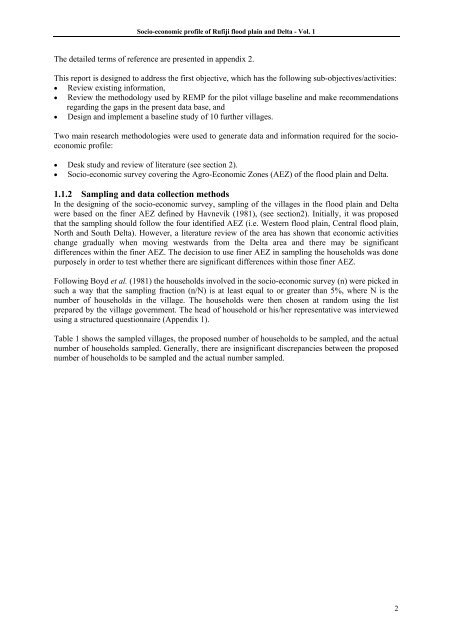A Socio-Economic Profile of the Rufiji Floodplain and Delta.
A Socio-Economic Profile of the Rufiji Floodplain and Delta.
A Socio-Economic Profile of the Rufiji Floodplain and Delta.
You also want an ePaper? Increase the reach of your titles
YUMPU automatically turns print PDFs into web optimized ePapers that Google loves.
<strong>Socio</strong>-economic pr<strong>of</strong>ile <strong>of</strong> <strong>Rufiji</strong> flood plain <strong>and</strong> <strong>Delta</strong> - Vol. 1<br />
The detailed terms <strong>of</strong> reference are presented in appendix 2.<br />
This report is designed to address <strong>the</strong> first objective, which has <strong>the</strong> following sub-objectives/activities:<br />
• Review existing information,<br />
• Review <strong>the</strong> methodology used by REMP for <strong>the</strong> pilot village baseline <strong>and</strong> make recommendations<br />
regarding <strong>the</strong> gaps in <strong>the</strong> present data base, <strong>and</strong><br />
• Design <strong>and</strong> implement a baseline study <strong>of</strong> 10 fur<strong>the</strong>r villages.<br />
Two main research methodologies were used to generate data <strong>and</strong> information required for <strong>the</strong> socioeconomic<br />
pr<strong>of</strong>ile:<br />
• Desk study <strong>and</strong> review <strong>of</strong> literature (see section 2).<br />
• <strong>Socio</strong>-economic survey covering <strong>the</strong> Agro-<strong>Economic</strong> Zones (AEZ) <strong>of</strong> <strong>the</strong> flood plain <strong>and</strong> <strong>Delta</strong>.<br />
1.1.2 Sampling <strong>and</strong> data collection methods<br />
In <strong>the</strong> designing <strong>of</strong> <strong>the</strong> socio-economic survey, sampling <strong>of</strong> <strong>the</strong> villages in <strong>the</strong> flood plain <strong>and</strong> <strong>Delta</strong><br />
were based on <strong>the</strong> finer AEZ defined by Havnevik (1981), (see section2). Initially, it was proposed<br />
that <strong>the</strong> sampling should follow <strong>the</strong> four identified AEZ (i.e. Western flood plain, Central flood plain,<br />
North <strong>and</strong> South <strong>Delta</strong>). However, a literature review <strong>of</strong> <strong>the</strong> area has shown that economic activities<br />
change gradually when moving westwards from <strong>the</strong> <strong>Delta</strong> area <strong>and</strong> <strong>the</strong>re may be significant<br />
differences within <strong>the</strong> finer AEZ. The decision to use finer AEZ in sampling <strong>the</strong> households was done<br />
purposely in order to test whe<strong>the</strong>r <strong>the</strong>re are significant differences within those finer AEZ.<br />
Following Boyd et al. (1981) <strong>the</strong> households involved in <strong>the</strong> socio-economic survey (n) were picked in<br />
such a way that <strong>the</strong> sampling fraction (n/N) is at least equal to or greater than 5%, where N is <strong>the</strong><br />
number <strong>of</strong> households in <strong>the</strong> village. The households were <strong>the</strong>n chosen at r<strong>and</strong>om using <strong>the</strong> list<br />
prepared by <strong>the</strong> village government. The head <strong>of</strong> household or his/her representative was interviewed<br />
using a structured questionnaire (Appendix 1).<br />
Table 1 shows <strong>the</strong> sampled villages, <strong>the</strong> proposed number <strong>of</strong> households to be sampled, <strong>and</strong> <strong>the</strong> actual<br />
number <strong>of</strong> households sampled. Generally, <strong>the</strong>re are insignificant discrepancies between <strong>the</strong> proposed<br />
number <strong>of</strong> households to be sampled <strong>and</strong> <strong>the</strong> actual number sampled.<br />
2
















